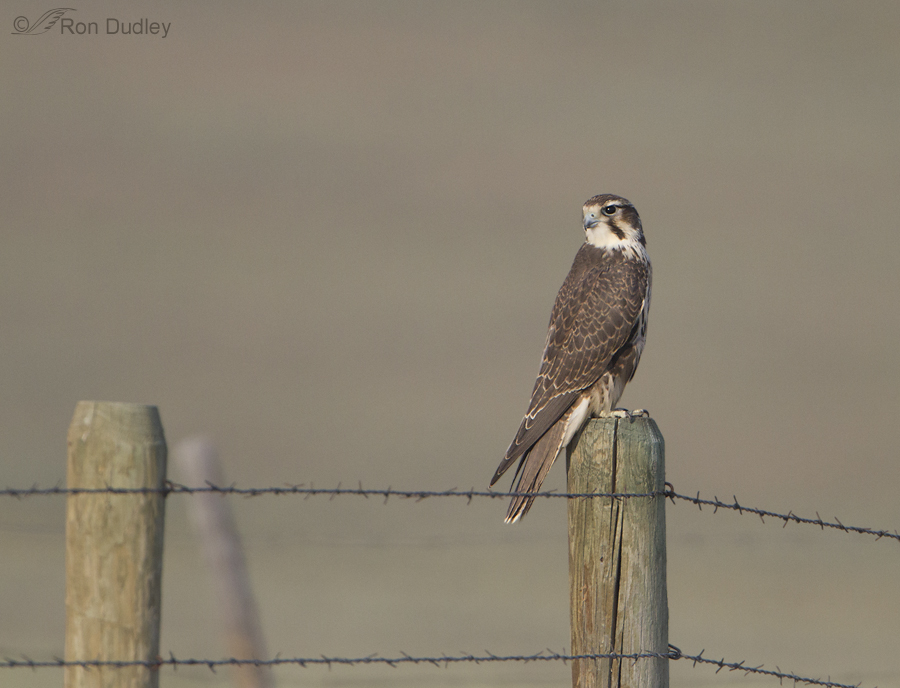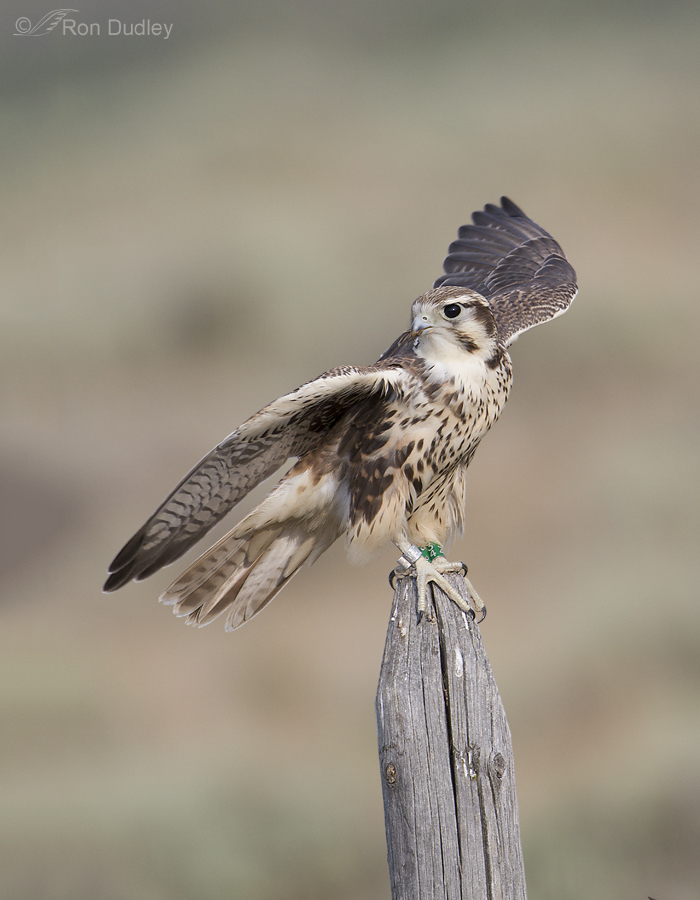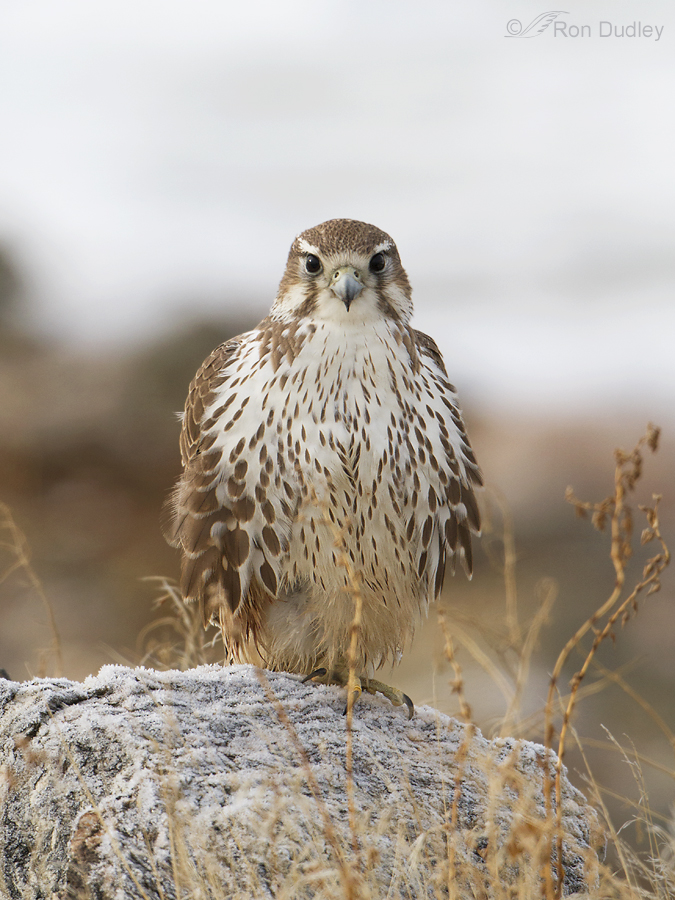Tag: prairie falcon
Montana Prairie Falcons And Hordes of Grasshoppers

I learned something last week in Montana’s Centennial Valley – Prairie Falcons eat insects.
In the past I’ve only seen them eat birds and small mammals and cursory research had backed up that observation but if you dig a little deeper in your research (Birds of North America Online, for example) you’ll find mention of lizards and insects being included in their diet. My friend (master falconer) Mark Runnels says that “Prairie Falcons will eat anything. In really bad years I have even heard of them feeding on carrion. You’ll never see a Peregrine do that!”
Prairie Falcon On A Frosty Rock
Prairie Falcon – A Dilemma
On this morning as I was leaving Antelope Island after a morning of shooting I was, as always, watching for a Prairie Falcon along the causeway. Occasionally I’ve been lucky with that strategy but it doesn’t happen very often. One advantage I had is the fact that if there was one there it would likely be perched on the rocks next to the Great Salt Lake. With that dark blue background, the bright whites on the breast of the falcon are often easy to spot. And that’s exactly what happened.
The Prairie Falcon And The Northern Shoveler
Back in November I blogged about my encounter with a Prairie Falcon and its Northern Shoveler prey. I thought that some of the images I didn’t use back then were worthy of another post. This falcon struck the duck on the water, then waited for it to die and to be washed up onto shore. 1/2500, f/6.3, ISO 640, 500 f/4, 1.4 tc, natural light, not baited, set up or called in It attempted to enjoy its meal at the water’s edge but waves kept coming in and “rocking the boat”… 1/2500, f/6.3, ISO 640, 500 f/4, 1.4 tc, natural light, not baited, set up or called in so the falcon decided to drag the shoveler further up the rocky shore and away from the annoying waves. 1/2500, f/6.3, ISO 640, 500 f/4, 1.4 tc, natural light, not baited, set up or called in It wasn’t an easy task. Average weight for Northern Shovelers is almost as much as it is for Prairie Falcons (1.3 vs 1.6 lbs) so the falcon really struggled in its attempt to drag the duck to a more suitable dining area. 1/2500, f/6.3, ISO 640, 500 f/4, 1.4 tc, natural light, not baited, set up or called in I thought this was an interesting shot with the wings up, the left foot off the ground and direct eye contact. 1/2500, f/6.3, ISO 640, 500 f/4, 1.4 tc, natural light, not baited, set up or called in Finally the falcon was satisfied with the…
Some Random Recent Images
I have an appointment early this morning so I don’t have time for a detailed, organized post so I thought I’d present a little potpourri from the last few weeks. Though none of these images are spectacular, there’s something about each one of them that appealed to me in some way. Common Ravens are a hugely challenging subject for me because of their uncooperative behavior and the difficulty of getting detail in the blacks. For some reason, these birds really seem to eat a lot of snow, which this one had been doing just before take-off. I do wish the head were slightly sharper but I like the remnants of the snow-eating behavior and how cleanly the bird is presented against the background which is the Great Salt Lake with the snow-covered shoreline at bottom right. Finding water that isn’t ice-covered around here isn’t easy, for me or for the critters, but I think that’s the only reason this Muskrat came as close to me as it did. I found this one at a pond close to my home. Ok, not a classic wing position for sure but the aerodynamic profile of this fast flying Prairie Falcon still appealed to me. I also like the eye contact and crisp detail in flight. Life is tough for Coyotes right now as they live in a stark white world of deep snow which makes survival difficult. Many of them wear an almost perpetual snow mask from pushing their faces through the snow as they try to follow…
My Recent Encounters With The Female Prairie Falcon
As regular readers of my blog know, I’ve had four close-up encounters with this female Prairie Falcon on the Antelope Island causeway over the last couple of months. I couldn’t resist posting some images of her in different poses that I haven’t published here previously. There is general agreement among folks who are much more knowledgeable about falcons than I am that it was the same bird in all four cases. 1/640, f/4.5, ISO 640, 500 f/4, natural light, not baited, set up or called in Here she is on 10/7/12. I’ll never forget that morning because she let me get closer than I had ever been to a wild Prairie Falcon (even had to remove my tc). But there was a tradeoff (isn’t there always?) because the reason she felt so secure was that she was in deep shade, which isn’t the best situation for photography. Still, I’m happy to have the images of her that morning. 1/2000, f/6.3, ISO 640, 500 f/4, 1.4 tc, natural light, not baited, set up or called in A little over a month later (11/11/12) she killed a Northern Shoveler in the water about 50 yards out and waited for it to drift to shore. Here she has just claimed her prize and seemed to raise her wings in celebration. 1/2500, f/6.3, ISO 640, 500 f/4, 1.4 tc, natural light, not baited, set up or called in She attempted to enjoy her meal on the shore edge but waves kept coming in and sloshing the duck around so she decided to drag it further away…
Another Encounter With The Antelope Island Prairie Falcon
Two days ago we located the Prairie Falcon on the causeway once again. This bird spends most of its time on the island itself but occasionally ventures onto the causeway to hunt ducks. I’m quite sure, as are others who are more falcon knowledgeable than I, that it’s the same individual in all of my recent Prairie Falcon posts. Usually I complain about not being able to get close enough to my subjects but here I had the opposite problem. The only way I could even see this bird was from very close. From any further away the falcon was completely obstructed by the road edge and the vegetation growing there. The first two images are essentially full frame (very little crop) and that’s without my tc attached, so the falcon is too tight in the frame but this post is more about falcon adaptations than it is about aesthetics anyway. 1/1600, f/9, ISO 500, 500 f/4, natural light, not baited, set up or called in This bird was a mess! It had apparently just finished dining on duck so it was wet, blood encrusted and disheveled, with tidbits still clinging to feet and beak. The bird is meticulously cleaning and scratching its beak with those impressive talons, which seems to me to be about like picking one’s teeth with a Bowie knife. 1/1600, f/9, ISO 500, 500 f/4, natural light, not baited, set up or called in But what I found particularly interesting about many of the images I took of this bird was the good look at the well-defined and bulging crop. …
Prairie Falcon Redux
It’s been 16 days since I’ve seen a Prairie Falcon along the causeway and I had just about given up on them for the short-term. But yesterday, as I was leaving the island after a relatively fruitless morning, I spotted that distinctive flash of bright breast whites up ahead among the rocks and very close to the road. Sure enough, as I got closer I could tell it was Falco mexicanus perched on a colorful boulder. 1/3200, f/6.3, ISO 640, 500 f/4, 1.4 tc, natural light, not baited, set up or called in, background is the Great Salt Lake I’ll sheepishly admit to the fact that in situations like this I typically come down with a case of “buck fever” (aggravated by the fact that I have familial tremors) and sure enough I was actually shaking with excitement and dread as I tried to maneuver my pickup to get a clear shot of the bird through all the vegetation along the road. With this particular perch, this was the most unobstructed view I could get. In case you’re wondering what the source of my “dread” could be, I’m a dedicated pessimist at heart (which Mia mercilessly teases me about) and I’m always convinced that the bird will take off a split second before I get the pickup stopped in a safe place and my finger on the shutter. That exact thing had happened twice that morning with Red-tailed Hawks. 1/1600, f/6.3, ISO 500, 500 f/4, 1.4 tc, natural light, not baited, set up or called in, background is…
An Incredible Experience With A Prairie Falcon And A Hapless Duck
This morning on Antelope Island was a photographic bust – heavy snow coming down most of the time and no light to speak of. So finally, after several hours of hoping the clouds would clear, we put our tails between our legs and headed for home. Talk about perfect timing! We’d traversed about half the causeway when the clouds parted, light blossomed and a serendipitous adult Prairie Falcon appeared, hunting for ducks. The falcon ambushed this male Northern Shoveler just as I was getting my pickup in position, so I missed that shot but this one was taken within a second or two of the strike. The duck is bleeding heavily. It struggled for a minute or so, and then died in the water. After the attack, the falcon would perch along the causeway for a short period, then take off and fly over the duck. This was done repeatedly. With my 500mm plus tc I could never get both the duck and the falcon in the image – this is as close as I came. 1/1600, f/5.6, ISO 500, 500 f/4, 1.4 tc, natural light, not baited, set up or called in Here, the falcon is perched to watch the duck out on the water. 1/2500, f/5.6, ISO 500, 500 f/4, 1.4 tc, natural light, not baited, set up or called in I had a difficult time locking focus on the falcon as it buzzed the duck because the textured water background was so close to the bird. I kept getting sharp shots of…
Prairie Falcon In Flight, With Prey
This image may look familiar to some viewers because I’ve previously posted another photo of this bird with a different wing position. I only got those two sharp shots of the falcon and I’d never processed this image before because the bird was too tight in the frame. I’d actually forgotten about this photo until recently when I decided it was worth making the effort to add some canvas to improve the composition. 1/2000, f/6.3, ISO 500, 500 f/4, natural light, not baited, set up or called in I found this juvenile feeding on its duck kill along the Antelope Island causeway last winter on a dark and blustery late morning. Two ravens began to harass the falcon with the apparent intention of stealing the duck so the rightful owner of the prey took off with the prize in tow. Within seconds, an adult Bald Eagle moved in and forced the falcon to drop the duck. One thing I find interesting about this image is the angle of the bird to the horizon – it looks like it’s flying downward, but in reality it’s actually gaining altitude. Normally, with the bird at this flight attitude, I’d rotate counterclockwise a little to make the flight angle more realistic looking, but since the horizon is in the background it’s obvious that the shot doesn’t need rotation since the horizon is level. The reason for the angled flight attack is the load that the falcon is hauling while it’s trying to gain altitude. The lower background is the dark, stormy and…
A Good Look At The Feather Patterns Of A Prairie Falcon
Last month, this Prairie Falcon let me get very close to it on the causeway to Antelope Island. It was in early morning and the bird was in deep shade. It’s my impression that they feel less threatened in that kind of light and though it makes for very difficult photography, I’ll take the bird close in poor light, instead of a mile away in gorgeous light – any ol’ day of the week. 1/640, f/4.5, ISO 640, 500 f/4, natural light, not baited, set up or called in Previously, I’ve posted a different image of this bird but that one didn’t have the textures provided by the raised feathers that we see here. 1/800, f/4.5, ISO 640, 500 f/4, natural light, not baited, set up or called in When this bird decided it was time to leave it had a bit of a pleasant surprise for me. In this light and with this slow shutter speed I could never get the bird sharp as it took off but just before it launched, it spread its wings and held them there for a few seconds and it even glanced back enough for me to get some light in the eye. But what I like most about this image is the great look at the feather patterns on the left wing and back. Because of the spread wing and the lightly colored margins on each feather, those patterns are very clear and it is easy to delineate each plumage “group” – primaries, secondaries, primary coverts, greater coverts, median coverts, lesser coverts, alula, scapulars,…
The Challenges Of Photographing Falcons On Antelope Island
There are three species of Falcons that reside on Antelope Island through much of the year – the American Kestrel, Prairie Falcon and Peregrine Falcon. A fourth, the Merlin, is mostly a winter resident. For many of us there’s something almost mystical about falcons and most bird photographers I know ache to get quality shots of them. But doing so isn’t easy anywhere and Antelope Island is no exception. In my experience there are three reasons why falcons on the island are so difficult to photograph well: The falcons are there but, with the exception of the kestrel, they’re difficult to find. For most of the year Peregrines and Prairies hang out in the remotest parts of the island that are inaccessible to us due to park rules and difficulties of negotiating such steep terrain. However, all three species hunt the causeway during winter so that’s the best chance for the photographer. Generally you just can’t get close to them. Kestrels are notorious for that trait, probably because they’re so common that lots of folks try with them. But common certainly doesn’t mean approachable. It’s not unusual to see a Peregrine perched far out on the mud flats but there’s no way to get close and if you tried they’d fly off. Prairie Falcons can often be spotted high up on the rocks around the central part of the island but they’re invariably much too far away and seldom perch near the road. Peregrines and Prairies are much easier to approach in very low light, especially just before sunup. But low light makes for crappy images. I’ve…
Clumsy Prairie Falcon
This young Prairie Falcon had apparently been hunting ducks near the edge of the Great Salt Lake and got some of its belly feathers wet so it landed on a rock near the lake for some rest and preening. It posed for me for over 12 minutes which I appreciated but the light was low and variable due to the ever-changing thickness of the clouds. 1/800, f/6.3, ISO 500, 500 f/4, 1.4 tc At first the falcon was fairly wary of me because I was quite close. 1/800, f/6.3, ISO 500, 500 f/4, 1.4 tc But after a few minutes it settled into its preening again. 1/2000, f/5.6, ISO 640, 500 f/4 But this was a juvenile bird and not quite so suave and sure of its movements as an adult would be and suddenly it slipped on its perch and would have fallen backwards if it hadn’t caught itself with its wings and climbed back up on the rock. Even though I didn’t get much light in the eye I still got lucky on this shot. I’d been shooting this bird with my tc attached and at a relatively slow shutter speed and the falcon pretty much filled the frame. Just before I took this image I removed my tc and ratcheted up my ISO to get more shutter speed for a possible take-off shot. If I hadn’t done that the wings would likely have been soft from motion blur and I’d have cut off parts of the bird with the tc attached. …
Just A Shot That I LIke… #23 – Prairie Falcon Take-Off
This morning I found this Prairie Falcon on top of a huge boulder – big enough that I was looking up at the bird. Its tail was hidden for the perched shots so my best hope was for take-off photos. 1/3200, f/6.3, ISO 500, 500 f/4, 1.4 tc When it did lift off it started out in my direction which didn’t give me the best light on the bird. After the first wing beat it banked to the birds left which was ideal for good light. Only problem – I clipped a wing on all those shots. Maybe next time I’ll remember to take off the teleconverter! Ron



